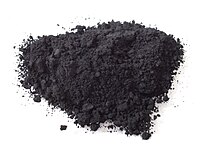
Photo from wikipedia
Abstract This short communication investigated the characteristics and sources of refractory black carbon (rBC) aerosols using an Aerodyne soot-particle aerosol mass spectrometer (SP-AMS). The SP-AMS dataset acquired at suburban Nanjing… Click to show full abstract
Abstract This short communication investigated the characteristics and sources of refractory black carbon (rBC) aerosols using an Aerodyne soot-particle aerosol mass spectrometer (SP-AMS). The SP-AMS dataset acquired at suburban Nanjing observed carbon clusters (Cn+) up to n = 160, which was classified into three groups (low-C: C1+-C5+; mid-C: C6+-C31+; full-C (fullerenes): C32+-C160+). A simple method was first developed to reduce influences of organic molecules on the Cn+ signals. We found that the temporal variations of low-C and mid-C varied similarly, but were substantially different from full-C, indicating different source contributions. Furthermore, positive matrix factorization analyses showed that the C1+/C3+ ratios of traffic-, industry-, cooking-related rBC were 0.88, 1.29 and 0.01, respectively. We propose such C1+/C3+ ratios can be used as references to distinguish different sources for rBC in ambient conditions, yet further verifications with more field data are still required, and whether or not such ratios in rBC cores are stable upon atmospheric ageing remains to be elucidated.
Journal Title: Atmospheric Environment
Year Published: 2018
Link to full text (if available)
Share on Social Media: Sign Up to like & get
recommendations!